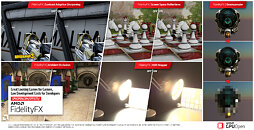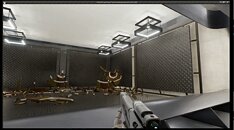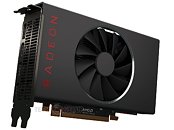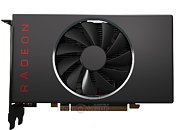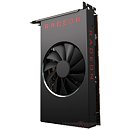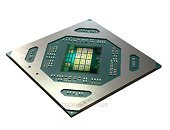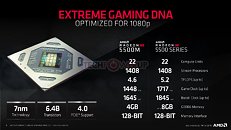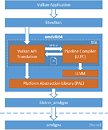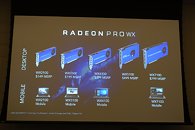Apr 6th, 2025 16:18 EDT
change timezone
Latest GPU Drivers
New Forum Posts
- RX 9000 series GPU Owners Club (193)
- What local LLM-s you use? (149)
- How I made an Ultimate Cooling Guide (20)
- A dozen drivers for HD4670, and which do I choose? (7)
- I have a bricked XFX Radeon RX 580 8GB GPU. HELP! (12)
- Do you use Linux? (560)
- TPU's F@H Team (20422)
- 9070XT or 7900XT (27)
- Share your AIDA 64 cache and memory benchmark here (3046)
- The easiest way to connect the BOOTSEL test metal terminal and the GND terminal.... (0)
Popular Reviews
- ASUS Prime X870-P Wi-Fi Review
- UPERFECT UStation Delta Max Review - Two Screens In One
- PowerColor Radeon RX 9070 Hellhound Review
- Corsair RM750x Shift 750 W Review
- DDR5 CUDIMM Explained & Benched - The New Memory Standard
- Upcoming Hardware Launches 2025 (Updated Apr 2025)
- Sapphire Radeon RX 9070 XT Pulse Review
- Sapphire Radeon RX 9070 XT Nitro+ Review - Beating NVIDIA
- AMD Ryzen 7 9800X3D Review - The Best Gaming Processor
- Pwnage Trinity CF Review
Controversial News Posts
- MSI Doesn't Plan Radeon RX 9000 Series GPUs, Skips AMD RDNA 4 Generation Entirely (146)
- NVIDIA GeForce RTX 5060 Ti 16 GB SKU Likely Launching at $499, According to Supply Chain Leak (124)
- Microsoft Introduces Copilot for Gaming (124)
- AMD Radeon RX 9070 XT Reportedly Outperforms RTX 5080 Through Undervolting (119)
- NVIDIA Reportedly Prepares GeForce RTX 5060 and RTX 5060 Ti Unveil Tomorrow (115)
- Over 200,000 Sold Radeon RX 9070 and RX 9070 XT GPUs? AMD Says No Number was Given (100)
- NVIDIA GeForce RTX 5050, RTX 5060, and RTX 5060 Ti Specifications Leak (97)
- Nintendo Switch 2 Launches June 5 at $449.99 with New Hardware and Games (92)
News Posts matching #GPUOpen
Return to Keyword Browsing
AMD Releases Unreal Engine 5.5 Plugins for Anti-Lag 2 and FSR 3.1.3
AMD on Monday released Unreal Engine plugins for FidelityFX Super Resolution (FSR) 3.1.3 and AMD Anti-Lag 2 through its GPUOpen initiative. Both plugins support the latest Unreal Engine 5.5, and can be picked up by game developers to integrate with their ongoing projects or be released as updates to their released games. FSR 3.1.3 succeeds the FSR 3.1.1 major release that had introduced Anti-Lag 2 support among a dozen other updates. The latest FSR version adds Unreal Engine 5.5 support, besides a minor update to the way FSR handles UseDistortionTexture commands. Meanwhile, the Anti-Lag 2 plugin for Unreal Engine 5.5 is being released as part of the latest v2.0.2 release of the technology. There are no other changes. AMD FSR 3.1.3 plugin for Unreal Engine 5.5 can be accessed here, and the Anti-Lag 2 plugin for UE 5.5 here.

AMD Releases Frame Latency Meter (FLM) Utility through GPUOpen
AMD today released the first public version of FLM, or Frame Latency Meter, a utility that lets you measure the response time of games with mouse movements. The tool targets advanced gamers, power users, and game developers wanting to optimize whole-system latency or reducing input latency. It measures the time it takes for a mouse movement to translate into a new frame on the screen. Options are included to use frame capture codecs such as AMF (optimized for AMD GPUs) or DXGI (any brand of GPUs). The tool generates detailed latency and effective-framerate statistics that can be exported to CSVs for data analysis. A key difference between FLM and NVIDIA LDAT is that it doesn't rely on "muzzle flashes" on the screens to measure latency, which means your measurement data can span any amount of time without worrying about running out of ammo during your test session.
DOWNLOAD: AMD Frame Latency Meter (FLM) v1.0
DOWNLOAD: AMD Frame Latency Meter (FLM) v1.0

AMD Releases FidelityFX SDK v1.1 to GPUOpen, Includes FSR 3.1 Source Code
AMD today released the FidelityFX SDK 1.1 to the public through its GPUOpen initiative. This update includes the source code to FSR 3.1, which should make it easier for game developers to understand the technology, and integrate it with their games. FSR 3.1 requires an AMD Radeon RX 5000 series (or later) GPU, or an NVIDIA GeForce RTX 20-series (or later) GPU, although the company recommends at least an RX 6000 series or RTX 30-series GPU, regardless of model. You get the full upscaling and frame-generation capabilities of FSR 3.1 on all supported GPUs, across AMD and NVIDIA, which is the main pull for the tech, as the rival DLSS 3 Frame Generation technology only works on RTX 40-series (or later) GPUs.
AMD FSR 3.1 builds on top of FSR 3 by introducing updates to the upscaler. If you recall, the star attraction with FSR 3 has been frame-generation, but the underlying upscaling tech had been carried over from FSR 2.2. FSR 3.1 introduces some much-needed updates to the quality of upscaling, and introduces new upscaler quality presets, including a native AA mode analogous to NVIDIA's DLAA. These increases in upscaler quality lets you trade in quality for performance better. You can find all the resources you need on FSR 3.1 here.
AMD FSR 3.1 builds on top of FSR 3 by introducing updates to the upscaler. If you recall, the star attraction with FSR 3 has been frame-generation, but the underlying upscaling tech had been carried over from FSR 2.2. FSR 3.1 introduces some much-needed updates to the quality of upscaling, and introduces new upscaler quality presets, including a native AA mode analogous to NVIDIA's DLAA. These increases in upscaler quality lets you trade in quality for performance better. You can find all the resources you need on FSR 3.1 here.

Microsoft DirectSR Runtime Based on AMD FSR 2.2
Microsoft revealed that its DirectSR (Direct Super Resolution) API, which seeks to standardize super resolution-based performance enhancement technologies in games, has a hardware-independent default code path that is essentially based on AMD FSR 2.2, a Microsoft Dev Manager speaking at GDC has revealed. DirectSR provides a common set of APIs for game developers to integrate super resolution—so that developers don't have to separately implement DLSS, FSR and XeSS. Rather these upscalers, and others, can register themselves with the DirectSR API, and then get fed a dozen of input parameters that they may (or may not) use to improve the upscaling quality. Since AMD has open-sourced the code of FSR 2.2 on GPUOpen, and it is entirely shader-based, and doesn't use exotic technologies such as AI, Microsoft decided to use FSR 2.2 as the base algorithm for DirectSR. If other algorithms like DLSS are available on the user system, these can be activated by the user, too, of course, but supporting them requires no extra work from the developer side.Update 18:15 UTC: Updated the news post to make it clear that the FSR 2.2 code path is merely a default, and other upscalers are free to hook into DirectSR to provide upscaling.

AMD Announces FSR 3.1, Improves Super Resolution Quality, Allows Frame Generation to Work with Other Upscaling Tech
AMD at GDC 2024 announced the FidelityFX Super Resolution 3.1 (FSR 3.1). While the original FSR 3.0 feature-set largely carries forward the super resolution upscaler from FSR 2.2, adding frame generation on top; the new FSR 3.1 adds several image quality improvements to the upscaler itself, improving image quality at every performance preset. Specifically, it improves the temporal stability of the output at rest and in movement, to reduce flickering and shimmering, or "fizziness" around objects in motion. The new upscaler also reduces ghosting, and better preserves detail.
Next up, is a rather important change in the way the frame generation technology works. AMD has decoupled FSR 3.1 frame generation from the upscaling tech, which allows frame generation to work with other upscaling solutions, such as DLSS or XeSS. The possibilities of such a decoupling are endless—have an RTX 30-series "Ampere" GPU that lacks DLSS 3 frame generation support? No worries, use DLSS 2 for the upscaling, and FSR 3.1 for the frame generation. AMD is also clumping its FidelityFX family of technologies into a new FidelityFX API that makes it easier for developers to debug, and paves the way for forward-compatibility with future versions of FSR. Lastly, FSR 3.1 supports Vulkan API, and the Microsoft Xbox GDK. AMD plans to release FSR 3.1 to developers through its GPUOpen platform in Q2-2024, and its first implementations on games are expected later this year. In the meantime, AMD implemented FSR 3.1 on "Ratchet & Clank: Rift Apart," to showcase the new upscaler.
Next up, is a rather important change in the way the frame generation technology works. AMD has decoupled FSR 3.1 frame generation from the upscaling tech, which allows frame generation to work with other upscaling solutions, such as DLSS or XeSS. The possibilities of such a decoupling are endless—have an RTX 30-series "Ampere" GPU that lacks DLSS 3 frame generation support? No worries, use DLSS 2 for the upscaling, and FSR 3.1 for the frame generation. AMD is also clumping its FidelityFX family of technologies into a new FidelityFX API that makes it easier for developers to debug, and paves the way for forward-compatibility with future versions of FSR. Lastly, FSR 3.1 supports Vulkan API, and the Microsoft Xbox GDK. AMD plans to release FSR 3.1 to developers through its GPUOpen platform in Q2-2024, and its first implementations on games are expected later this year. In the meantime, AMD implemented FSR 3.1 on "Ratchet & Clank: Rift Apart," to showcase the new upscaler.

The Last of Us Part I Gets AMD FSR 3 Support
Naughty Dog, developer of "The Last of Us Part I" released a small patch for the Windows PC version of the game, which adds official support for FidelityFX Super Resolution 3 (FSR 3). This includes support for both FSR 3 Frame Generation, and FSR 3 Super Resolution. Today's update takes the count of games that officially support FSR 3 up to 19. There are unofficial ways to mod most popular games to support AMD's latest upscaling tech, thanks to the algorithm being freely available through AMD's GPUOpen platform.

AMD Posts "Super Early" Work Graphs Render Time Numbers, Posts 39% Render Time Improvements
AMD in a GPUOpen blog post showed off some "super early" performance numbers for a Radeon RX 7900 XTX GPU rendering a DirectX 12 workload using Work Graphs, instead of the traditional ExecuteIndirect method. Work Graphs is method by with GPUs enjoy greater autonomy in executing render and general purpose compute workloads, by vastly reducing the role of the CPU in the rendering pipeline. At the ongoing GDC 2024, AMD showed off a performance demo of a DirectX 12 rendering workload that implements Work Graphs, running in sync with Mesh Nodes, a feature that will process draw calls while the rest of the graph is executing. This is compared its render times to the traditional method. The differences are staggering.
It takes the traditional ExecuteIndirect method 64% longer to render a frame compared to Work Graphs, in other words, the new method is 39% faster. This has a direct impact on frame-rates for applications that implement Work Graphs. Although not part of the demo, AMD RDNA 3 also implement a silicon-level acceleration for Multi-draw indirect, another API-level feature that's underutilized. AMD's demo showcases a 3D scene without the HUD UI and skybox, being rendered on a single work graph dispatch. Work Graphs and Mesh Nodes are the next big feature addition to the DirectX 12 API feature-set, which will begin rolling out later this year. Both AMD and NVIDIA have ongoing implementation efforts to implement it.
It takes the traditional ExecuteIndirect method 64% longer to render a frame compared to Work Graphs, in other words, the new method is 39% faster. This has a direct impact on frame-rates for applications that implement Work Graphs. Although not part of the demo, AMD RDNA 3 also implement a silicon-level acceleration for Multi-draw indirect, another API-level feature that's underutilized. AMD's demo showcases a 3D scene without the HUD UI and skybox, being rendered on a single work graph dispatch. Work Graphs and Mesh Nodes are the next big feature addition to the DirectX 12 API feature-set, which will begin rolling out later this year. Both AMD and NVIDIA have ongoing implementation efforts to implement it.

AMD Releases Adrenalin Edition 23.40.14.01 for Agility SDK Support
AMD today released its first drivers to implement Microsoft's DirectX Agility SDK version 1.613, which introduces the new DirectX 12 Work Graphs 1.0 API. AMD has extensively worked on implementing the new technology, which among other things, significantly reduces the CPU's role in most common shader graphics workloads, and improve GPU shader thread saturation, as the GPU waits less on the CPU's share of shader workloads. The new AMD Software Adrenalin 23.40.14.01 drivers are off the main driver update channel, and is intended for developers and enthusiasts to start exploring GPU Work Graphs. GPU Upload Heaps, and certain features of Shader Model 6.8 on supported AMD Radeon GPUs. There are some known issues with the driver specific to AMD's implementation of GPU Work Graphs, and the latest version of the Agility SDK in general, which are listed below.
DOWNLOAD: AMD Software Adrenalin 23.40.14.01 for Agility SDK Support
DOWNLOAD: AMD Software Adrenalin 23.40.14.01 for Agility SDK Support

Microsoft's Latest Agility SDK Released with Cutting-edge Work Graphs API
Microsoft's DirectX department is scheduled to show off several innovations at this month's Game Developers Conference (GDC), although a late February preview has already spilled their DirectSR Super Resolution API's beans. Today, retail support for Shader Model 6.8 and Work Graphs has been introduced with an updated version of the company's Agility Software Development Kit. Program manager, Joshua Tucker, stated that these technologies will be showcased on-stage at GDC 2024—Shader Model 6.8 arrives with a "host of new features for shader developers, including Start Vertex/Instance Location, Wave Size Range, and Expanded Comparison Sampling." A linked supplementary article—D3D12 Work Graphs—provides an in-depth look into the cutting-edge API's underpinnings, best consumed if you have an hour or two to spare.
Tucker summarized the Work Graphs API: "(it) utilizes the full potential of your GPU. It's not just an upgrade to the existing models, but a whole new paradigm that enables more efficient, flexible, and creative game development. With Work Graphs, you can generate and schedule GPU work on the fly, without relying on the host. This means you can achieve higher performance, lower latency, and greater scalability for your games with tasks such as culling, binning, chaining of compute work, and much more." AMD and NVIDIA are offering driver support on day one. Team Red has discussed the launch of "Microsoft DirectX 12 Work Graphs 1.0 API" in a GPUOpen blog—they confirm that "a deep dive" into the API will happen during their Advanced Graphics Summit presentation. NVIDIA's Wessam Bahnassi has also discussed the significance of Work Graphs—check out his "Advancing GPU-driven rendering" article. Graham Wihlidal—of Epic Games—is excited about the latest development: "we have been advocating for something like this for a number of years, and it is very exciting to finally see the release of Work Graphs."
Tucker summarized the Work Graphs API: "(it) utilizes the full potential of your GPU. It's not just an upgrade to the existing models, but a whole new paradigm that enables more efficient, flexible, and creative game development. With Work Graphs, you can generate and schedule GPU work on the fly, without relying on the host. This means you can achieve higher performance, lower latency, and greater scalability for your games with tasks such as culling, binning, chaining of compute work, and much more." AMD and NVIDIA are offering driver support on day one. Team Red has discussed the launch of "Microsoft DirectX 12 Work Graphs 1.0 API" in a GPUOpen blog—they confirm that "a deep dive" into the API will happen during their Advanced Graphics Summit presentation. NVIDIA's Wessam Bahnassi has also discussed the significance of Work Graphs—check out his "Advancing GPU-driven rendering" article. Graham Wihlidal—of Epic Games—is excited about the latest development: "we have been advocating for something like this for a number of years, and it is very exciting to finally see the release of Work Graphs."

AMD FSR 3 with Frame Generation Comes to Call of Duty MW:III and Warzone
Official support for AMD FidelityFX Super Resolution 3 (FSR 3), including support for Frame Generation, has been extended to Call of Duty Modern Warfare III and Warzone, though their latest game patch. This adds FSR 3 as an option, which lets you choose between five performance presets—Ultra Performance, Performance, Balanced, Quality, and Native; with Native being analogous to NVIDIA's DLAA preset—a quality enhancement at native resolution, without upscaling. With the "AMD FSR 3.0" upscaling/sharpening option selection, you also get Frame Generation as a separate toggle, which nearly doubles frame rates using AMD's interpolation technology.
Call of Duty MW:III and Warzone are arguably the biggest game franchise to implement FSR 3 so far. The list of officially supported FSR 3 titles is small, with just five other titles that include Avatar: Frontiers of Pandora, Forspoken, Immortals of Aveum, Like a Dragon Gaiden: The Man Who Erased His Name; and Motorcubs RC; however, with AMD posting the FSR 3 source code to GPUOpen, the game modding community is all over the feature, extending unofficial FSR 3 and Frame Generation mods to games not on this list. It's worth noting that the latest CoD MW:III patch has FSR 3 replace the FSR 2.1 option entirely.
Call of Duty MW:III and Warzone are arguably the biggest game franchise to implement FSR 3 so far. The list of officially supported FSR 3 titles is small, with just five other titles that include Avatar: Frontiers of Pandora, Forspoken, Immortals of Aveum, Like a Dragon Gaiden: The Man Who Erased His Name; and Motorcubs RC; however, with AMD posting the FSR 3 source code to GPUOpen, the game modding community is all over the feature, extending unofficial FSR 3 and Frame Generation mods to games not on this list. It's worth noting that the latest CoD MW:III patch has FSR 3 replace the FSR 2.1 option entirely.

Community Mod Brings FSR 3 Frame Generation to Cyberpunk 2077
AMD last week released the FSR 3 source code to public through its GPUOpen initiative, and the modding community wasted no time in bringing the feature to popular games such as "The Last of Us: Part 1," and now, "Cyberpunk 2077." CD Projekt Red will probably bring official FSR 3 support to the game at some point, but for those who can't wait, there's DLSS3-to-FSR3 by Nukem9. Put simply, this is a DLSS 3 DLL that you replace your game's DLSS 3 library file with; which gets the game to use FSR 3 instead of DLSS 3 Frame Generation.
The latest version of DLSS3-to-FSR3 adds "Cyberpunk 2077" support, and there's an extensive guide written by AndreasLyUs on Reddit, on how to integrate it with your "Cyberpunk 2077" installation, so you can enable FSR 3. Neegzm on YouTube, published a video review on how FSR 3 mods for "Cyberpunk 2077" look and perform compared to DLSS 2. You can expect a frame-rate jump from 25 FPS with DLSS 2 Quality to 47 FPS with FSR 3 enabled. The FSR 3 mod should be particularly useful for those on older NVIDIA RTX 30-series "Ampere" GPUs, or all Radeon RX 6000 and RX 7000 GPUs. Those on RTX 40-series can just take advantage of the official DLSS 3 Frame Generation support to see comparable frame-rates.
The latest version of DLSS3-to-FSR3 adds "Cyberpunk 2077" support, and there's an extensive guide written by AndreasLyUs on Reddit, on how to integrate it with your "Cyberpunk 2077" installation, so you can enable FSR 3. Neegzm on YouTube, published a video review on how FSR 3 mods for "Cyberpunk 2077" look and perform compared to DLSS 2. You can expect a frame-rate jump from 25 FPS with DLSS 2 Quality to 47 FPS with FSR 3 enabled. The FSR 3 mod should be particularly useful for those on older NVIDIA RTX 30-series "Ampere" GPUs, or all Radeon RX 6000 and RX 7000 GPUs. Those on RTX 40-series can just take advantage of the official DLSS 3 Frame Generation support to see comparable frame-rates.

AMD Releases FSR 3 Source Code on GPUOpen
AMD on Thursday announced the first release of FidelityFX Super Resolution 3 (FSR 3) source code through the company's GPUOpen initiative. The company just set up an FSR 3 source code repo on GitHub that game devs everywhere can take advantage of. This includes the complete source for DirectX 12, and the source of an FSR 3 Unreal Engine 5 plugin. With it, the company also released extensive documentation that helps developers understand the inner workings of FSR 3, so they could better integrate the tech with their games and applications. With this announcement, AMD also unveiled FSR 3 support for even more new and upcoming games, which include "Black Myth: Wukong," the three latest titles from the "Warhammer" franchise, including "Darktide," "Space Marine II," and "Realms of Ruin;" "Starfield," "Pax Dei," and "Crimson Desert."

AMD FSR 2.2 for Unreal Engine now available on GPUOpen
Although it has already been available in some games, AMD's FidelityFX Super Resolution 2.2 is now available as an Unreal Plugin over on GPUOpen. AMD's FidelityFX Super Resolution 2 has been already used in some games ever since AMD released the source code for the technology, which includes the titles like Forza Horizon 5, Need For Speed Unbound, and F1 22, but implementation in various engines can take time, and now it is available as a plugin for Unreal Engine. AMD's FSR 2.2 brings several improvements including new logic that should reduce "High-Velocity Ghosting," an issue that usually plagues racing games. It also feature a new Debug API Checker, which should provide much easier debugging for developers.

AMD FidelityFX Super Resolution 2.1 Unveiled with Several Upscaler Changes to Improve Realism
AMD late Thursday unveiled the FidelityFX Super Resolution 2.1 (FSR 2.1) performance enhancement, which builds on the performance-quality gains of FSR 2.0, while improving the visual fidelity and correcting several kinds of upscaling artifacts visible to the keen eye. To begin with, it corrected ghosting issues with geometry carrying motion vectors not matching the underlying pixel colors, which were causing a "shimmering" effect. There are also changes to the disocclusion logic that let it detect disocclusions in areas with little depth separating objects, which again should address some ghosting issues.
Upscaled output quality has been improved by turning some upscaler computations from FP16 to FP32 (full-precision), which should improve color range and temporal stability of the upscaled image. Ghosting issues on transparent geometry has also been improved by updates to the reactive mask. Ghosting issues on geometry with motion vectors not matching underlying pixel colors have been addressed with improvements to the composition and transparency mask. AMD detailed FSR 2.1 in its GPUOpen page, and has made the software available to game developers. Any game currently implementing FSR 2.0 can release FSR 2.1 support through patches. The latest version 1.7.1 patch of Farming Simulator 2022 implements FSR 2.1.AMD also put together a video presentation with Farming Simulator 2022, highlighting the improvements made with FSR 2.1.
Upscaled output quality has been improved by turning some upscaler computations from FP16 to FP32 (full-precision), which should improve color range and temporal stability of the upscaled image. Ghosting issues on transparent geometry has also been improved by updates to the reactive mask. Ghosting issues on geometry with motion vectors not matching underlying pixel colors have been addressed with improvements to the composition and transparency mask. AMD detailed FSR 2.1 in its GPUOpen page, and has made the software available to game developers. Any game currently implementing FSR 2.0 can release FSR 2.1 support through patches. The latest version 1.7.1 patch of Farming Simulator 2022 implements FSR 2.1.AMD also put together a video presentation with Farming Simulator 2022, highlighting the improvements made with FSR 2.1.

AMD Introduces Radeon Raytracing Analyzer 1.0
Today, the AMD GPUOpen announced that AMD developed a new tool for game developers using ray tracing technologies to help organize the model geometries in their scenes. Called Radeon Raytracing Analyzer (RRA) 1.0, it is officially available to download for Linux and Windows and released as a part of the Radeon Developer Tool Suite. With rendering geometries slowly switching from rasterization to ray tracing, developers need a tool that will point out performance issues and various workarounds in the process. With RRA, AMD has enabled all Radeon developers to own a tool that will answer many questions like: how much memory is the acceleration structure using, how complex is the implemented BVH, how many acceleration structures are used, does geometry in the BLAS axis align enough, etc. Developers will find it very appealing for their ray tracing workloads.
AMDRRA is able to work because our Radeon Software driver engineers have been hard at work, adding raytracing support to our Developer Driver technology. This means that once your application is running in developer mode - using the Radeon Developer Panel which ships with RRA - the driver can log all of the acceleration structures in a scene with a single button click. The Radeon Raytracing Analyzer tool can then load and interrogate the data generated by the driver, presenting it in an easy-to-understand way.

AMD Releases FidelityFX Super Resolution 2.0 Source Code Through GPUOpen
Today marks a year since gamers could try out AMD FidelityFX Super Resolution technology for themselves with our spatial upscaler - FSR 1. With the introduction of FSR 2, our temporal upscaling solution earlier this year, there are now over 110 games that support FSR. The rate of uptake has been very impressive - FSR is AMD's fastest adopted software gaming technology to date.
So it seems fitting that we should pick this anniversary day to share the source code for FSR 2, opening up the opportunity for every game developer to integrate FSR 2 if they wish, and add their title to the 24 games which have already announced support. As always, the source code is being made available via GPUOpen under the MIT license, and you can now find links to it on our dedicated FSR 2 page.
So it seems fitting that we should pick this anniversary day to share the source code for FSR 2, opening up the opportunity for every game developer to integrate FSR 2 if they wish, and add their title to the 24 games which have already announced support. As always, the source code is being made available via GPUOpen under the MIT license, and you can now find links to it on our dedicated FSR 2 page.

AMD Reveals More FidelityFX Super Resolution 2.0 Technical Details
AMD has recently shared some more technical information on their recently announced FidelityFX Super Resolution successor ahead of their GDC presentation. The GPUOpen developer website has been updated with new details regarding the various quality modes and implementation strategies available for FSR 2.0. AMD has confirmed that FSR 2.0 will work with graphics cards from AMD and NVIDIA going back to the Pascal GTX 10 series in addition to the Xbox Series X/S.
The technology is similar to NVIDIA DLSS 2.0 in that they both use temporal upscaling however FSR 2.0 does not rely on Machine Learning which makes the technology easier to integrate and allows more devices to be supported. FSR 2.0 will feature four quality options with Quality, Balanced, and Performance in addition to the optional Ultra-Performance mode that developers can choose to add. AMD has also included support for Dynamic Resolution Scaling where the resolution can be automatically scaled to meet a minimum target frame rate.
The technology is similar to NVIDIA DLSS 2.0 in that they both use temporal upscaling however FSR 2.0 does not rely on Machine Learning which makes the technology easier to integrate and allows more devices to be supported. FSR 2.0 will feature four quality options with Quality, Balanced, and Performance in addition to the optional Ultra-Performance mode that developers can choose to add. AMD has also included support for Dynamic Resolution Scaling where the resolution can be automatically scaled to meet a minimum target frame rate.

AMD FidelityFX Super Resolution (FSR) Plugin for Unreal Engine 4 Released
AMD released the FidelityFX Super Resolution (FSR) plugin for Unreal Engine 4, allowing game developers to integrate the performance enhancement technology with their games. A competing technology to NVIDIA DLSS, FSR lets gamers improve frame-rates of their games by trading off quality. At the higher "Quality" presets, this quality loss is supposed to be practically unnoticeable, but with significant improvements to frame-rates. We detailed how the technology works in our article that gets under its hood and evaluates performance. At its launch, AMD listed out a broad list of launch partners for the technology, but Unreal was a notable absentee. Over the following months, AMD appears to have worked toward bringing the tech to even UE4. The plugin is being distributed through AMD's GPUOpen portal.
DOWNLOAD: AMD FSR Plugin for Unreal Engine 4
DOWNLOAD: AMD FSR Plugin for Unreal Engine 4

AMD Announces Radeon RX 6600 Graphics Card
AMD today launched the AMD Radeon RX 6600 graphics card, designed to provide visually stunning, high-refresh rate 1080p gaming experiences to the midrange market. The AMD Radeon RX 6600 graphics card leverages breakthrough AMD RDNA 2 architecture, the only gaming architecture that spans from desktop PCs, laptops and consoles to mobile devices and automotive infotainment systems. Offering 32 MB of high-performance AMD Infinity Cache, 8 GB of GDDR6 memory, AMD Smart Access Memory technology and support for the Microsoft Windows 11 operating system, the AMD Radeon RX 6600 graphics card is designed to bring next-generation desktop-level experiences to PC gamers. It also supports the AMD FidelityFX Super Resolution open-source spatial upscaling solution, which is designed to increase framerates in select titles while delivering high-resolution gaming experiences.
The AMD Radeon RX 6600 graphics card is designed with the needs of future-ready, high-performance 1080p gamers in mind. Capable of driving 100+ FPS in top AAA titles, the AMD Radeon RX 6600 graphics card also offers up to 1.3X better performance-per-watt than the competition in select titles in 1080p at max settings.
The AMD Radeon RX 6600 graphics card is designed with the needs of future-ready, high-performance 1080p gamers in mind. Capable of driving 100+ FPS in top AAA titles, the AMD Radeon RX 6600 graphics card also offers up to 1.3X better performance-per-watt than the competition in select titles in 1080p at max settings.

AMD FidelityFX FSR Source Code Released & Updates Posted, Uses Lanczos under the Hood
AMD today in a blog post announced several updates to the FidelityFX Super Resolution (FSR) technology, its performance enhancement rivaling NVIDIA DLSS, which lets gamers dial up performance with minimal loss to image quality. To begin with, the company released the source code of the technology to the public under its GPUOpen initiative, under the MIT license. This makes it tremendously easy (and affordable) for game developers to implement the tech. Inspecting the source, we find that FSR relies heavily on a multi-pass Lanczos algorithm for image upscaling. Next up, we learn that close to two dozen games are already in the process of receiving FSR support. Lastly, it's announced that Unity and Unreal Engine support FSR.
AMD broadly detailed how FSR works in its June 2021 announcement of the technology. FSR sits within the render pipeline of a game, where an almost ready lower-resolution frame that's been rendered, tone-mapped, and anti-aliased, is processed by FSR in a two-pass process implemented as a shader, before the high-resolution output is passed on to post-processing effects that introduce noise (such as film-grain). HUD and other in-game text (such as subtitles), are natively rendered at the target (higher) resolution and applied post render. The FSR component makes two passes—upscaling, and sharpening. We learn from the source code that the upscaler is based on the Lanczos algorithm, which was invented in 1979. Media PC enthusiasts will know Lanczos from MadVR, which has offered various movie upscaling algorithms in the past. AMD's implementation of Lanczos-2 is different than the original—it skips the expensive sin(), rcp() and sqrt() instructions and implements them in a faster way. AMD also added additional logic to avoid the ringing effects that are often observed on images processed with Lanczos.
AMD broadly detailed how FSR works in its June 2021 announcement of the technology. FSR sits within the render pipeline of a game, where an almost ready lower-resolution frame that's been rendered, tone-mapped, and anti-aliased, is processed by FSR in a two-pass process implemented as a shader, before the high-resolution output is passed on to post-processing effects that introduce noise (such as film-grain). HUD and other in-game text (such as subtitles), are natively rendered at the target (higher) resolution and applied post render. The FSR component makes two passes—upscaling, and sharpening. We learn from the source code that the upscaler is based on the Lanczos algorithm, which was invented in 1979. Media PC enthusiasts will know Lanczos from MadVR, which has offered various movie upscaling algorithms in the past. AMD's implementation of Lanczos-2 is different than the original—it skips the expensive sin(), rcp() and sqrt() instructions and implements them in a faster way. AMD also added additional logic to avoid the ringing effects that are often observed on images processed with Lanczos.

AMD Adds Four New Graphics Technologies to Its FidelityFX Software Stack via GPUOpen
AMD today via its newly released GPUOpen website has announced that it is adding four new graphics technologies to its FidelityFX software stack. Before you ask, no; there is no included Ray Tracing graphics libraries among these four new technologies. However, considering the use-case for these is to give developers an almost plug-in flexibility on various graphics technologies they would otherwise have to find other ways to integrate in their rendering pass, added layers to GPUOpen are always a welcome sight. And rest assured that "classic" shading techniques will still be widely used even in the advent of top to bottom raytracing capabilities on graphics hardware - which likely won't happen in the next GPU hardware generation anyway.
Added technologies to the previously-released Contrast Adaptive Sharpening are libraries for SSSR (Stochastic Screen Space Reflections) for better reflections without the usage of raytracing; CACAO (Combined Adaptive Compute Ambient Occlusion) for added depth to shadows and object quality; LPM (Luminance Preserving Mapper) for eased application of an HDR rendering pipeline with correct values, preventing overblown details; and SPD (Single Pass Downsampler) which will allow developers to seamlessly downsample required assets (think something along the lines of Variable Rate Shading) to achieve FPS targets. The GPUOpen is an effort from AMD to create an open graphics library that will allow developers to easily integrate AMD-optimized technologies to their graphics workflow.
Added technologies to the previously-released Contrast Adaptive Sharpening are libraries for SSSR (Stochastic Screen Space Reflections) for better reflections without the usage of raytracing; CACAO (Combined Adaptive Compute Ambient Occlusion) for added depth to shadows and object quality; LPM (Luminance Preserving Mapper) for eased application of an HDR rendering pipeline with correct values, preventing overblown details; and SPD (Single Pass Downsampler) which will allow developers to seamlessly downsample required assets (think something along the lines of Variable Rate Shading) to achieve FPS targets. The GPUOpen is an effort from AMD to create an open graphics library that will allow developers to easily integrate AMD-optimized technologies to their graphics workflow.

AMD Publishes FEMFX Deformable Physics Library on GPUOpen
FEMFX is a multithreaded CPU library for deformable material physics, using the Finite Element Method (FEM). Solid objects are represented as a mesh of tetrahedral elements, and each element has material parameters that control stiffness, how volume changes with deformation, and stress limits where fracture or plastic (permanent) deformation occur. The model supports a wide range of materials and interactions between materials. We intend for these features to complement rather than replace traditional rigid body physics. The system is designed with the following considerations:

AMD Introduces Radeon RX 5500 Series Graphics Cards
Today, AMD announced the Radeon RX 5500 series graphics products, harnessing groundbreaking RDNA gaming architecture to deliver the ultimate in high-performance, high-fidelity 1080p gaming. The AMD Radeon RX 5500 series includes the Radeon RX 5500 graphics card that will be available in desktop PCs from leading manufacturers and graphics cards from board partners, as well as the Radeon RX 5500M GPU for notebook PCs. Top system providers worldwide are embracing the new products, with HP and Lenovo planning to offer Radeon RX 5500 graphics cards in their high performance desktop gaming PCs beginning this November, and Acer planning to offer systems with the cards beginning this December. In addition, later this month MSI is expected to launch the world's first gaming notebook powered by AMD Ryzen processors and Radeon RX 5500M GPUs.
"Based on feedback and insights from global gaming communities, gamers rank graphics as the most critical component for speed and performance," said Johnson Jia, senior vice president and general manager, Consumer Business of Intelligent Devices Group, Lenovo. "That's why the Lenovo Legion T730 and T530 gaming towers and the IdeaCentre T540 Gaming desktop pack in AMD's latest Radeon RX graphics - satisfying players' need for high-fidelity visuals and lightning-fast frame-rates to fully immerse into their gameplay." "MSI Alpha 15 is a new chapter for us, and we're excited to partner with AMD to combine the latest 7 nm technology found in the Radeon RX 5500M GPU and MSI's gaming DNA for our gamers," said Charles Chiang, CEO of MSI.
"Based on feedback and insights from global gaming communities, gamers rank graphics as the most critical component for speed and performance," said Johnson Jia, senior vice president and general manager, Consumer Business of Intelligent Devices Group, Lenovo. "That's why the Lenovo Legion T730 and T530 gaming towers and the IdeaCentre T540 Gaming desktop pack in AMD's latest Radeon RX graphics - satisfying players' need for high-fidelity visuals and lightning-fast frame-rates to fully immerse into their gameplay." "MSI Alpha 15 is a new chapter for us, and we're excited to partner with AMD to combine the latest 7 nm technology found in the Radeon RX 5500M GPU and MSI's gaming DNA for our gamers," said Charles Chiang, CEO of MSI.

AMD Releases AMDVLK - Open-Source Vulkan Driver for Linux
AMD released the AMDVLK drivers for Linux. These are the first open-source AMD Radeon graphics drivers featuring 100% support for Vulkan 1.0 graphics API. The drivers include Vulkan 1.0 compliance with support for 30 Vulkan extensions, Radeon GPU Profiler support, in-built debug and profiling tools, mid-command buffer preemption, and SR-IOV virtualization support. AMDVLK implements AMD's Platform Abstraction Library (PAL), an abstraction layer that translates much of AMD's common driver code and features across platforms. The drivers support all AMD Radeon GPUs based on the Graphics CoreNext architecture, going all the way back to the Radeon HD 7000-series. The drivers are released through AMD's GPUOpen GitHub repository.

AMD Announces Radeon Pro Update With Vega Support
AMD today is announcing the latest update to their Radeon Pro Hardware and Software, which brings with it enhanced features designed to fully take advantage of the company's new high-performance Vega graphics micro-architecture. Namely, AMD has announced the Radeon Pro WX 9100, the Radeon Pro SSG, and Radeon Vega Frontier Edition (already launched) along with new Radeon Pro Software for the same.
As per AMD, the Radeon Pro WX 9100 workstation graphics card is designed to excel in the most demanding media and entertainment, and design and manufacturing workloads. Delivering up to 12.3 TFLOPS of peak single precision compute performance, the Radeon Pro WX 9100 graphics card represents a new era of professional graphics capabilities fueled by powerful Next-Gen Compute Units3 with Rapid Packed Math and an Enhanced Geometry Pipeline which improves processing efficiencies. Compared to the AMD FirePro W9100, the Radeon Pro WX 9100 runs models more than twice as fast, delivering over 2.6X the peak throughput-per-clock.
As per AMD, the Radeon Pro WX 9100 workstation graphics card is designed to excel in the most demanding media and entertainment, and design and manufacturing workloads. Delivering up to 12.3 TFLOPS of peak single precision compute performance, the Radeon Pro WX 9100 graphics card represents a new era of professional graphics capabilities fueled by powerful Next-Gen Compute Units3 with Rapid Packed Math and an Enhanced Geometry Pipeline which improves processing efficiencies. Compared to the AMD FirePro W9100, the Radeon Pro WX 9100 runs models more than twice as fast, delivering over 2.6X the peak throughput-per-clock.
Apr 6th, 2025 16:18 EDT
change timezone
Latest GPU Drivers
New Forum Posts
- RX 9000 series GPU Owners Club (193)
- What local LLM-s you use? (149)
- How I made an Ultimate Cooling Guide (20)
- A dozen drivers for HD4670, and which do I choose? (7)
- I have a bricked XFX Radeon RX 580 8GB GPU. HELP! (12)
- Do you use Linux? (560)
- TPU's F@H Team (20422)
- 9070XT or 7900XT (27)
- Share your AIDA 64 cache and memory benchmark here (3046)
- The easiest way to connect the BOOTSEL test metal terminal and the GND terminal.... (0)
Popular Reviews
- ASUS Prime X870-P Wi-Fi Review
- UPERFECT UStation Delta Max Review - Two Screens In One
- PowerColor Radeon RX 9070 Hellhound Review
- Corsair RM750x Shift 750 W Review
- DDR5 CUDIMM Explained & Benched - The New Memory Standard
- Upcoming Hardware Launches 2025 (Updated Apr 2025)
- Sapphire Radeon RX 9070 XT Pulse Review
- Sapphire Radeon RX 9070 XT Nitro+ Review - Beating NVIDIA
- AMD Ryzen 7 9800X3D Review - The Best Gaming Processor
- Pwnage Trinity CF Review
Controversial News Posts
- MSI Doesn't Plan Radeon RX 9000 Series GPUs, Skips AMD RDNA 4 Generation Entirely (146)
- NVIDIA GeForce RTX 5060 Ti 16 GB SKU Likely Launching at $499, According to Supply Chain Leak (124)
- Microsoft Introduces Copilot for Gaming (124)
- AMD Radeon RX 9070 XT Reportedly Outperforms RTX 5080 Through Undervolting (119)
- NVIDIA Reportedly Prepares GeForce RTX 5060 and RTX 5060 Ti Unveil Tomorrow (115)
- Over 200,000 Sold Radeon RX 9070 and RX 9070 XT GPUs? AMD Says No Number was Given (100)
- NVIDIA GeForce RTX 5050, RTX 5060, and RTX 5060 Ti Specifications Leak (97)
- Nintendo Switch 2 Launches June 5 at $449.99 with New Hardware and Games (92)






































